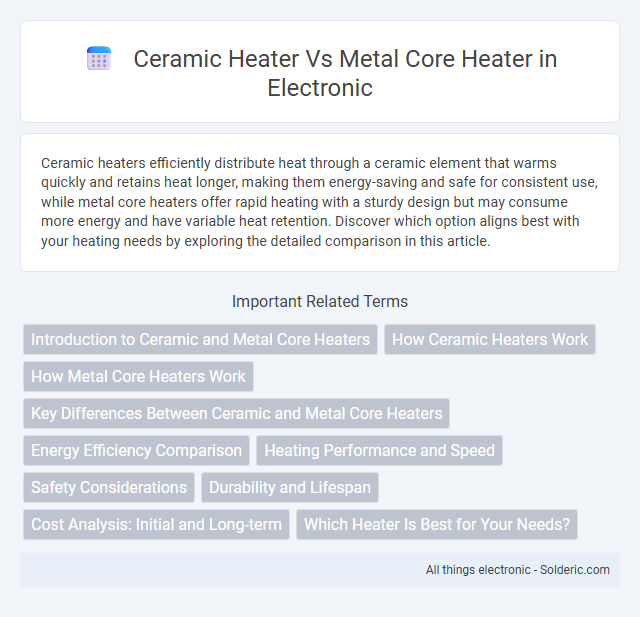Ceramic heaters efficiently distribute heat through a ceramic element that warms quickly and retains heat longer, making them energy-saving and safe for consistent use, while metal core heaters offer rapid heating with a sturdy design but may consume more energy and have variable heat retention. Discover which option aligns best with your heating needs by exploring the detailed comparison in this article.
Comparison Table
| Feature | Ceramic Heater | Metal Core Heater |
|---|---|---|
| Heating Element | Ceramic plates | Metal core (aluminum/copper) |
| Heat-Up Time | Fast (seconds) | Moderate (minutes) |
| Heat Distribution | Even and consistent | Gradual and concentrated |
| Durability | Moderate, can crack | High, resistant to wear |
| Energy Efficiency | High | Moderate to high |
| Cost | Generally affordable | Usually higher priced |
| Applications | Home heating, personal heaters | Industrial, heavy-duty heating |
| Safety | Cool-to-touch surfaces, safer | Hotter surfaces, risk of burns |
| Lifespan | 3-5 years | 5-10 years |
Introduction to Ceramic and Metal Core Heaters
Ceramic heaters use ceramic plates to generate heat, offering fast, efficient warming with excellent heat retention and even distribution. Metal core heaters rely on metal elements, typically aluminum or steel, providing robust durability and rapid heat conduction but may consume more energy. Choosing between ceramic and metal core heaters depends on your need for energy efficiency, heat output, and longevity.
How Ceramic Heaters Work
Ceramic heaters operate by using a ceramic heating element that warms up when electricity passes through it, emitting infrared heat that efficiently transfers warmth to the surrounding air. The ceramic core retains heat longer, allowing for consistent and even heating with lower energy consumption compared to metal core heaters. This design provides safer operation and faster heat distribution, making ceramic heaters ideal for energy-efficient indoor climate control.
How Metal Core Heaters Work
Metal core heaters operate by using a metal core, often made of aluminum or copper, which efficiently conducts heat generated by an electrical resistance element embedded within it. This design allows for rapid and even heat distribution as the metal core quickly transfers warmth to surrounding surfaces or air. Your heating system benefits from faster response times and improved durability compared to ceramic heaters, which rely on less conductive ceramic materials.
Key Differences Between Ceramic and Metal Core Heaters
Ceramic heaters use ceramic plates to generate heat, offering rapid warming and even heat distribution, while metal core heaters rely on metal elements that provide durability and sustained high temperatures. Ceramic models are energy-efficient with cooler surface temperatures ideal for safe, indoor use, whereas metal core heaters tend to have faster heat-up times but higher external temperatures. Your choice depends on whether you prioritize quick, consistent warmth or long-lasting heat resilience for specific environments.
Energy Efficiency Comparison
Ceramic heaters typically convert electricity into heat more quickly and with higher energy efficiency than metal core heaters, due to their rapid heat-up time and consistent thermal conductivity. Metal core heaters, while durable, often have slower heat distribution and require more energy to maintain desired temperatures. Studies show ceramic heating elements can reduce energy consumption by up to 30% compared to traditional metal core elements in household heating applications.
Heating Performance and Speed
Ceramic heaters excel in rapid heat-up times and even distribution due to their ceramic plates, which efficiently retain and radiate heat. Metal core heaters provide durable heating elements that maintain consistent temperatures but generally warm up more slowly compared to ceramic models. The superior thermal conductivity of ceramic materials results in faster heating performance and quicker room temperature regulation.
Safety Considerations
Ceramic heaters offer enhanced safety due to their cool-to-touch surfaces and automatic shut-off features, reducing the risk of burns and fire hazards. Metal core heaters, while efficient in heat conduction, can reach higher surface temperatures, posing a greater risk of accidental burns or fire if not carefully monitored. When choosing a heater, Your safety is best ensured by selecting models with built-in overheat protection and tip-over switches to prevent accidents.
Durability and Lifespan
Ceramic heaters offer enhanced durability due to their resistance to overheating and corrosion, allowing for a longer lifespan compared to metal core heaters. Metal core heaters, while efficient in heat transfer, are prone to oxidation and metal fatigue over time, which can reduce their operational longevity. Investing in ceramic heater technology ensures sustained performance and fewer replacements, making it a cost-effective choice for long-term heating solutions.
Cost Analysis: Initial and Long-term
Ceramic heaters typically have a moderate initial cost but offer superior energy efficiency, which can result in lower long-term electricity expenses compared to metal core heaters. Metal core heaters often come with a lower upfront price but may consume more power over time, increasing your overall operational costs. Evaluating your heating needs and usage patterns helps determine which option delivers better value for your investment.
Which Heater Is Best for Your Needs?
Ceramic heaters provide rapid, efficient heating with even temperature distribution, making them ideal for smaller spaces or quick warmth. Metal core heaters offer durability and sustained heat release, better suited for larger rooms or prolonged use. Consider your room size and heating duration to determine which heater best fits your needs.
Ceramic heater vs metal core heater Infographic

 solderic.com
solderic.com